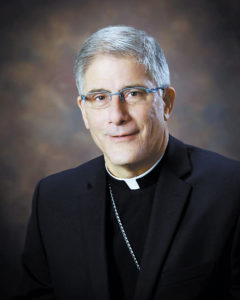
Bishop Joseph Kopacz
By Bishop Joseph Kopacz
The celebration of the Lord’s birth, the Incarnation, literally, the “Word became flesh, and pitched his tent among us,” (John 1, 14) is a dramatic proclamation of faith that God is in our midst and relentlessly pursues us in the wonderful story of salvation.
The literal translation of the tent in our midst is so apt because at any moment the Lord Jesus can pull up stakes and walk with us, or pursue us wherever we may go. This is the mystery that Pope Francis is pointing us towards in the Evangelii Guadium, the Joy of the Gospel, when he invites us to wrestle with the statement, “time is more important that space.”
When we encounter our living and loving incarnate Lord, or better said, when he grasps us (Phil 3, 14) we can joyfully shout, “Glory to God in the highest and peace on earth” (Luke 2, 14), because even if we remained silent the very stones would shout out. (Luke 19,40) The Infancy Narratives in their simplicity and in their sophistication intermingle darkness and light. Herod’s violence and hate, reeking havoc in our own time, pursues the Christ in order to destroy him and all associated with him. Yet, he could not silence the voices of the angels and shepherds, nor menace the Magi’s search for truth.
This holds true for us in our time because the voices of hate and violence against the Lord’s disciples, the Church, often only strengthens our resolve, especially in the blood of the martyrs. The Incarnation of the Lord must not be severed from his crucifixion and resurrection, and when we play it forward we can see a similar account in the story of Saint Paul.
For a time, he was Herod in disguise relentlessly hunting down the disciples of the Lord in order to destroy the nascent community of believers.
Joseph Holzner in his book Paul of Tarsus offers an inspired account of the beginning of Saul’s conversion in which we see the divine purpose of the Incarnation in action.
“He, Saint Paul, was the hunter driven by an insatiable thirst for the prey. However, in those days on the road to Damascus, another, the Master of those disciples he is hunting, is also on the trail. Paul thought that he was the hunter, but indeed, he was the quarry.
Christ is the Divine Hunter, the Hound of Heaven, and here on the road to Damascus he is running down a most precious quarry who will not be able to escape.”
God’s divine desire to embrace the heart and mind of every human being in Jesus Christ, the Word made Flesh, is at work in the Church at every moment throughout the world. Each of us and all people are most precious to Jesus Christ who inspires our hopes and dreams in his holy season. This work is evident throughout the Diocese of Jackson in season and out of season. (2Timothy 4, 2)
When we pause to reflect and treasure all these things in our hearts, as did Mary in the aftermath of the shepherds’ visit, we can see and hear the Gospel alive in ordinary and extraordinary ways, every day in the 65 counties of our diocese. In comparison to much larger Christian denominations, we may be small in number, but we are “proclaiming the Lord Jesus by living the Gospel so that all may experience the crucified and living Lord.” (Mission Statement)
I am grateful for so many coworkers in the Vineyard of the Lord who serve in numerous ministries and admirable ways to bring the Good News of Jesus Christ to the people of our time. Some of you have been serving for a long time. Some have pitched their tents among us just recently. In particular, on behalf of the entire Diocese of Jackson and many in Holmes County, I want to welcome Sister Mary Walz, DC, Sister Madeline Kavenaugh, DC, and Sister Sheila Conley, SC, who arrived last month to build back up the hope of the Gospel in the aftermath of Sister Paula and Sister Margaret’s murders a years and half ago.
With their own unique gifts forged in the fires of pastoral ministry over many years they will take up the torch of loving service in the name of the Lord Jesus. (See related story on page 4)
During the closing days of Advent may we pray that the way of the Lord in our lives is wide open to celebrate his birth into our lives through faith.
Merry Christmas.
